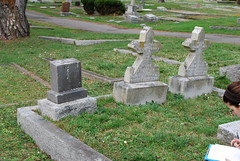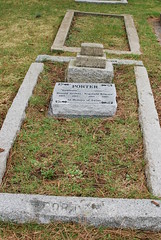 |
| Families placing flowers on the "mini burials" in Shanghai |
Today I read in the news about a developing burial trend in Shanghai. This new practice is a combination of cremation, sea burial, and internment. This new concept was designed to fill small vacant spaces in the Shanghai grave yards and to ensure less space was used in the future (China Daily 2011). According to Zhao Xiaohu, the manager of Binhaiguyuan Cemetery, the new partial sea burial was introduced as a “mid-point between traditional burials and sea burials" (China Daily 2011). In Shanghai, 99.5% of the cremated body is released into the ocean; the remaining ashes are buried in a container about the size of a matchbox (China Daily 2011). This allows for individuals to be cremated then dispersed at sea. However, this practice allows for their families to have a traditional grave marker and therefore a place to visit the deceased; in addition, families are able to continue burying the deceased together. Furthermore, the sea burial is beneficial because it is more environmentally friendly than traditional practices and it uses less space. This new practice not only dramatically reduces the cost of a funeral in Shanghai it also allows families to continue traditional practices. Essentially, this new practice is a joining of old and new customs.
 |
| American Navy sea burial off the USS Enterprise, 2003 |
Burial at sea is not a new concept. It has often been used by sailors, the navy, and in regions reliant on the ocean, like Newfoundland. It is commonly used in the Navy to redistribute the bodies of sailors lost at sea. However, in Shanghai the individuals selecting sea burial often do not have a direct relationship with the ocean. Individuals and families select the option for its cheapness, small environmental impact, and to be “one with nature” (China Daily 2011). This makes the increasing trend in the region unique.
However, this new practices is really being implemented because of the shortages of land in Shanghai. It is estimated by Xiaohu, that if cemeteries continue allotting 1.5 meter plots per grave site that the city will run out of burial spaces within ten years (China Daily 2011). Therefore, it was necessary for the city to develop a new tradition of burial which used minimal space, was environmentally friendly, AND incorporated traditional customs.
I think this practice is a fantastic way to meet both the needs of the city and the traditions of its citizens. This new custom allocates the continuity of traditional practices and for the preservation of the environment. Furthermore, this new tradition allows for the individual select a popular burial method that also gives their family a place to mourn and honour them. If I were to die I would want to be buried a way that not only comforted my family but also produced minimal impact upon the environment. I am personally an advocate for the practice of cremation because I like the idea of having my body become part of “the air and the wind and the trees and the earth and all the living things” (Pullman 1995). I feel that this new practice would allow me to become part of everything AND give my family a place to remember me.
I think this is a fantastic new practice which incorporates the old and the new. Other countries facing issues of overcrowded cemeteries, like Britain and Singapore, should consider implementing a similar customs. This would reduce the pressure on modern cemeteries and may allow them to avoid moving old burials to make way for new ones. Furthermore, it would allow for families to visit the cemetery and possible trace many generations of their ancestors.
References:
China Daily, 2011. Wasted Space in Cemeteries Inspires Mini-Burials. [Online]
(Updated 27 March 2011) Available at: http://english.eastday.com
/e/110328/u1a5809952.html (Accessed 27 March 2011)
Pullman, Philip, 1995. The Golden Compass. New York: Dell Yearling.
Image Credit:
Wikipedia, 2011. Burial at Sea. [Online] (Updated 10 March 2011)
Available at: http://en.wikipedia.org/wiki/Burial_at_sea (Accessed 27 March 2011)
China Daily, 2011. Wasted Space in Cemeteries Inspires Mini-Burials. [Online]
(Updated 27 March 2011) Available at: http://english.eastday.com
/e/110328/u1a5809952.html (Accessed 27 March 2011)





